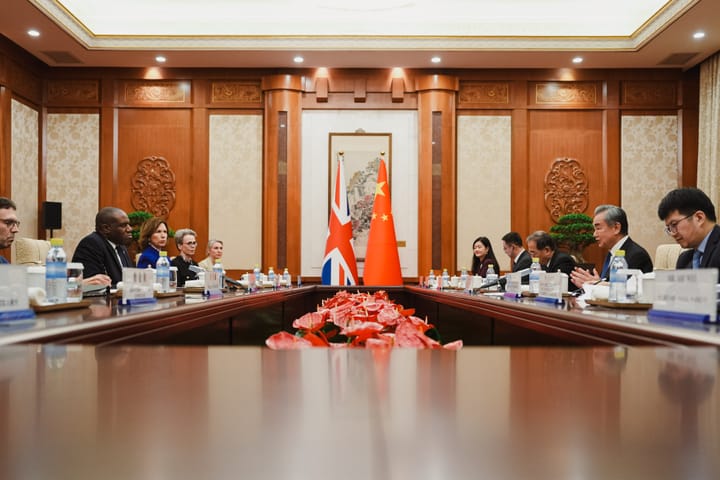China's Electric Future Is Here — And The U.S. Is Keeping It Out

Since 2014, Chinese electric vehicles have been dominating the global market in terms of both price and quality, according to MIT Technology Review. U.S. companies, on the other hand, can’t keep up due to restrictive government policies, and trade restrictions prevent Americans from buying these cheaper, better models.
China accounts for over half of all global Electric Vehicle sales. Data from the China Association of Automobile Manufacturers shows the number of EVs sold annually in the country grew from 1.4 million in 2020 to 9.5 million in 2023. In comparison, annual EV sales in the U.S. grew from 0.3 million in 2020 to 1.25 million in 2023. Furthermore, EVs are much cheaper in China than in the U.S.; the average price of a new EV in China is about $34,400 compared to about $55,242 in the U.S..
CHINA’S EV PLAYBOOK
In the early 2000s, the Chinese auto-industry was struggling in a global market dominated by U.S., German and Japanese automakers. Zeyi Yang, contributor on the MIT Technology Review, explains that despite being a manufacturing powerhouse, China could never have been able to compete with foreign car makers on internal-combustion vehicles.
Moreover, hybrid-car innovation was already being led by countries like Japan. Thus, the Chinese government decided to take a big risk and invest in a relatively new field: fully electric vehicles. This decision was also motivated by the desire to become more energy-independent, as China was — and still is — one of the world’s largest oil importers. The government also had public health concerns over excessive pollution in big cities.
The decision paid off: China now leads the world in EV innovation and adoption. One of the primary reasons behind the disparity between Chinese and American EVs is China’s superior battery technology, as the battery cell of an EV can account for up to 40% of the vehicle’s total cost, according to the World Electric Vehicle Journal. China’s rapid battery innovation can be attributed to both economic policies supporting companies and driving consumer demand as well as supply chain dominance ensuring cheap and reliable manufacturing.
Beginning in 2009, the Chinese government began implementing various policies to stimulate the EV industry, such as providing subsidies, cheap loans and cheap land leases to build factories. Stricter standards on battery quality were set to encourage battery advancement.
In addition, local governments contracted companies to electrify bus and taxi fleets, creating an artificial market before public consumer demand had built up. This boosted innovation and expanded production, leading to better and cheaper EVs.
The government fueled demand with consumer benefits like sales tax exemptions, discounted charging, and favorable parking. From 2009 to 2023, the government gave an estimated $230.9 billion to the industry through programs such as these.
Though consumer subsidies were phased out in 2022, the demand had already been established. In July, China hit a new milestone: over half of new car sales in the country were now electric.
Once the industry was well-established, the government began forcing foreign companies like Tesla to use Chinese-made batteries if they wanted to sell cars in the country, further ensuring China’s technological and economic control over EV batteries.
Meanwhile, China also dominates every step of the battery supply chain — from mining the raw materials to assembling the final battery. According to the New York Times, when averaging the five primary minerals and four major parts in a battery, China refines 74% of the world’s minerals and manufactures 81% of battery parts.
This makes it nearly impossible for foreign automakers to manufacture EVs without cooperating with China on some level. This gives the country immense economic control: China decides who gets the raw materials and batteries, and at what price.
RESTRICTING TRADE (AND INNOVATION)
As it stands, U.S. automakers are struggling to make affordable EVs due to government trade restrictions with China. U.S. consumers are prevented from buying these cheaper EVs, which limits market growth and impedes the adoption of sustainable transportation.
In February 2023, for example, Ford announced plans to build a new battery plant in Michigan using technology from CATL, the largest battery manufacturer in the world. If completed, it would be the U.S.’s first battery plant that manufactures LFP batteries — a new, cheaper type of battery. However, the project is now under investigation by the U.S. House of Representatives, which cites security concerns regarding Ford’s partnership with CATL, a Chinese-based company.
In a letter written to Ford’s CEO, two House Representatives raised concerns that if Ford becomes overly reliant on China for critical resources needed to manufacture EV batteries, it would hinder domestic competition — which the U.S. hopes to expand — and leave American EV-makers vulnerable to Chinese government policies.
The U.S. has been investing into EV technology as well, but it will take time to fully transition. Currently, most automakers still focus on internal combustion vehicles, which are much more profitable, though the trend is changing.
Regardless, the U.S. will likely have to transition to electrically-powered vehicles anyways if it is to meet its climate goals. So, the government faces a tough decision: keep its distance from China and attempt to expand domestic competition or go electric and support environmental sustainability.
ONGOING SOLUTIONS
Lithium Iron Phosphate (or LFP) is a new battery technology that could bypass China’s dominance of the mineral supply by replacing the two most expensive minerals — nickel and cobalt — with iron and phosphate, both of which are not only less expensive but also abundant in North America, leading to lower transportation costs and a more secure supply chain.
Due to lower costs, U.S. automakers see LFP as a way to provide consumers with affordable options. For instance, Tesla aims to provide alternatives to China’s low-priced EVs at a mere $25,000 using LFP tech.
The LFP industry is still growing, but currently, 99% of LFP cathodes are manufactured in China, according to the New York Times. This makes competing with China on new battery technology extremely difficult, not to mention U.S. policies that prevent bilateral cooperation between Chinese and American companies.
While the U.S. could loosen its trade restrictions and increase cooperation with countries in Europe and North America in an attempt to gain a foothold in the LFP industry, the effectiveness of these policies is not clear.
The U.S. has also tried implementing many of the same economic policies that first built up China’s EV market. For example, the federal government is offering up to 7,500 dollars in tax credit to consumers who buy new EVs. But there’s a catch: the vehicle must be made in North America, which leaves consumers with less advanced models that often still cost more.
That’s not to say that economic policies have no effect. American EVs are becoming cheaper as companies continue to innovate and demand rises. By 2029, the World Economic Forum projects EVs will have a net-positive profit. By 2040, 85% of new vehicle sales in the U.S. are projected to be electric.
Even so, this may be too slow. To reach the U.S.’s objective of having net-zero carbon emissions by 2050, 100% of new vehicle sales in the U.S. must be electric by 2035.
The U.S. likely has the potential to reach this goal, but as long as American automakers are barred from cooperating with Chinese EV-makers, battery innovation will remain slow and prices high. Ford in particular is projected to lose $5.5 billion this year on its EV models.
THE NOT-SO-HARD TRUTH
No matter how profitable traditional internal-combustion cars are currently, EVs are the future of transportation. Not only are they vastly more climate-friendly, they also have better fuel efficiency, performance and longevity, and are quickly becoming cheaper to manufacture, buy and maintain.
If the U.S. is to reclaim its competitive position in the EV sector and reach its climate goals, the government must permit and encourage cooperation between American and Chinese companies. If the government cares more about national security and attempting to thwart Chinese economic growth through trade wars, however, then consumers, auto-companies, and environmental activists alike will all remain dissatisfied with costlier, technologically-inferior EVs.
The U.S. must prioritize the sustainability of its transportation and energy and accept that cooperation with China on some level is unavoidable.
By granting U.S. companies access to state-of-the-art technology, EVs will rapidly become the cheaper option and adoption will become widespread, propelling our country and the world to a cleaner, more sustainable, and more cooperative future.



